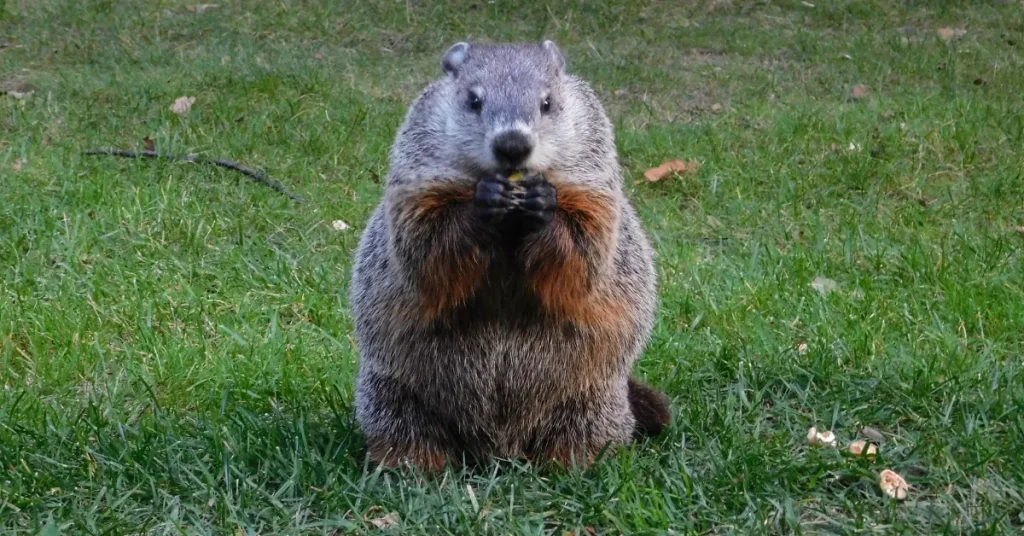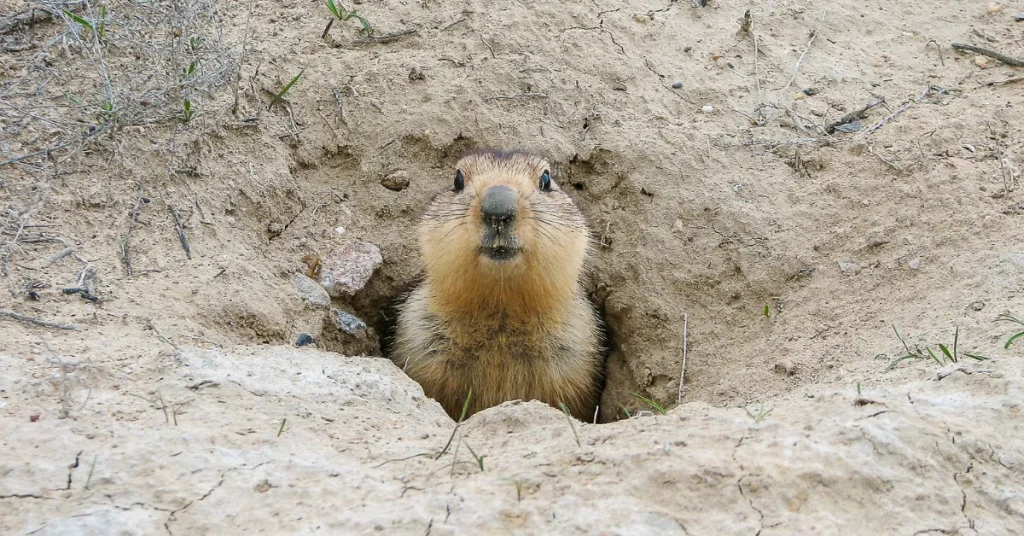Groundhog burrows typically extend 2 to 5 feet deep. The tunnels may spread out to 45 feet wide.
Groundhogs, also known as woodchucks, are master excavators, creating extensive burrow systems to serve as their homes.
Amidst grassy fields and backyard gardens, these burly rodents find refuge underground, where they can evade predators, rear their young, and hibernate through winter.
Understanding the depth and complexity of groundhog burrows is essential for homeowners and gardeners, as these structures can affect the integrity of the soil and landscape.
These subterranean architects spend a considerable amount of their lives in these hidden labyrinths, which include multiple entrances and chambers for various uses.
Preventing and managing groundhog intrusions requires insight into their digging habits, highlighting the importance of knowing just how deep and elaborate these holes can be.

The Secret Life Of Groundhogs
Groundhogs, also known as woodchucks, are famous for their weather prediction folklore.
Yet, there’s much more to these creatures than the quirky Groundhog Day celebrations reveal. Their burrows are complex structures and understanding them uncovers the hidden behaviors and social interactions of these fascinating animals.
Habitat And Burrowing Behaviors
Groundhogs prefer woodlands and fields close to water sources. Their burrows are ingenious feats of animal engineering with multiple entrances. Here’s how a typical groundhog hole breaks down:
- Main entrance: Usually with a large mound of dirt outside.
- Escape tunnel: A secret exit to flee predators.
The depth of these burrows can be as much as 5 feet underground, with tunnels stretching up to 30 feet in length.
Layouts differ, but a typical burrow will have:
- A nesting chamber where they sleep and rear young.
- Waste tunnels to keep the nest clean.
The thorough design helps regulate temperature and safety.
Social Structure In Groundhog Burrows
Groundhogs are mostly solitary. Only during the breeding season do these animals share their space. The burrow becomes a hub for raising pups and social interaction during this time.
Single-entry burrows are generally individual shelters, while complex multichamber burrows may house a family.
Let’s look at the occupants:
| Age | Role | Duration |
| Adults | Protect and teach | Spring season |
| Youths | Learn and play | Until independence |
When fall arrives, groundhogs prefer solitude again. They retreat to their own burrows to hibernate, each in its own specially prepared space.
Diving Into The Depths
Curious about the world beneath our feet, especially where groundhogs dwell? Let’s plunge into the underground architecture of these furry architects. Groundhogs, also known as woodchucks, create impressive burrows.
These subterranean homes play a crucial role in their survival. They provide shelter, a place to hoard food, and a safe space to rear their young. So, just how deep do these holes go? Let’s explore the intricate details of groundhog burrows.
Average Measurements Of Burrows
Typically, a groundhog’s hole might appear modest from the outside. However, it has multiple chambers and extensive tunnels. On average, these homes measure:
- 2 to 5 feet in depth, to avoid frost lines and predators
- 8 to 66 feet in length, with several escape routes
- Entrances spanning up to 10-12 inches in diameter
These dimensions reflect ideal conditions, yet various factors can alter these norms.
Depth Variances By Region And Climate
Digging deeper, we uncover that groundhog burrows can differ based on their location. In regions where the soil is loose and easy to excavate, burrows could stretch longer and deeper.
Conversely, in areas with hard soil or rocky terrain, these burrows might be shorter and less complex. Climate also influences burrow depth. In colder climates, groundhogs dig deeper to escape the frost, whereas in milder conditions, the burrows needn’t be as deep.
Let’s visualize these variances through a table:
| Region | Typical Depth | Reason |
| Northern Climates | 4-5 feet | To evade frost |
| Southern Climates | 2-3 feet | Less frost penetration |
| Rocky Terrain | Varies | Depends on rock distribution |
These adaptable creatures engineer their homes for optimal survival, ensuring the security and warmth they require.
Architectural Marvels Underground
Imagine a secret world right under our feet. Groundhogs create amazing homes below the surface. These animals are not just skilled diggers, but true architects of the animal kingdom.
Their burrows are complex and serve multiple purposes. Let’s explore the remarkable design and uses of these underground structures.
Design And Structure Of Groundhog Burrows
A groundhog’s burrow is a feat of engineering. Their homes are not just simple holes. Each one is a maze of tunnels leading to different chambers. They design their homes to protect themselves from predators and harsh weather.
- Entrances: Multiple entries ensure quick escapes.
- Tunnel Length: Tunnels can extend up to 45 feet long.
- Depth: Burrows are typically 2-5 feet deep.
Heavier groundhogs tend to dig deeper and more extensive burrows. These structures anchor them in the soil, keeping them cool in summer and warm in winter.
Their engineering skills make these burrows last for years. Other animals often use empty groundhog homes for shelter.
Multi-chamber Burrows And Their Uses
Every groundhog burrow is a multi-room residence. They feature specialized areas for every part of groundhog life.
| Chamber | Purpose |
| Nesting Chamber: | For sleeping and rearing young. |
| Bathroom Chamber: | For waste; helps keep nest clean. |
| Food Storage: | For stashing food for winter months. |
Each chamber has its own special design. For example, nesting chambers are lined with grass for comfort. Groundhogs are clean animals. They dig specific chambers just for waste to keep their living spaces sanitary.
Burrows protect groundhogs from cold and predators. The snug, leaf-lined nesting chambers offer a warm retreat in winter.
The food storage chambers are like a pantry; groundhogs fill them with food to help them through the cold months.
In summary, groundhog burrows are not just holes, but complex homes. These structures showcase the animal’s instinct for design, with each chamber serving a distinct purpose for living underground.
Groundhog Holes Impact On The Ecosystem

The hidden architecture of groundhog burrows often goes unnoticed. These holes are more than just dwelling places for the animals.
They play a significant role in the ecosystem. Groundhogs, also known as woodchucks, create complex tunnel systems that can be quite deep.
Soil Aeration And Benefits To Vegetation
Groundhog burrowing activities naturally aerate the soil. This process involves creating spaces in the ground that allow air, water, and nutrients to penetrate deeper into the soil. Here’s how this benefits the vegetation:
- Improves soil structure by allowing roots to grow deeper.
- Enhances water infiltration, reducing soil erosion and runoff.
- Promotes better nutrient uptake for plants, leading to healthier ecosystems.
Shared Spaces: Other Species Using Groundhog Burrows
Groundhog holes aren’t just for groundhogs. These burrows welcome a variety of other species. They provide shelter and breeding grounds for numerous animals. Let’s take a look at some of these species:
| Species | Use of Burrow |
| Foxes | Seek refuge and a spot to raise young. |
| Rabbits | Escape from predators and harsh weather. |
| Frogs and Toads | Stay moist and cool during hot days. |
| Skunks | Find a safe and warm home. |
These shared spaces show the groundhog’s role in supporting biodiversity. Groundhogs enhance their ecosystems, contributing to the health and longevity of many species.
Identifying And Safely Exploring Groundhog Burrows

Curious about groundhog burrows? Understanding these fascinating underground structures provides insight into the lives of these animals.
Identifying and safely exploring these burrows requires careful steps to ensure the safety of both groundhogs and humans. Let’s dig into the techniques for locating and assessing the complexity of these intriguing animal homes.
Locating Entrances And Tunnels
Groundhog holes are typically 10 to 12 inches in diameter. They often have loose dirt scattered around the entrance. Look for these signs:
- Flat, well-worn paths leading to the hole indicate frequent usage.
- Nearby plants with trimmed stems are a sign of a groundhog’s diet.
- Secondary holes may also exist, used for emergency escapes.
To further explore, note the positioning of the entrance holes. This can hint at the direction of tunnels.
Precautions To Protect Groundhogs And Humans
Before delving into a groundhog’s home, consider these safety steps:
| Action | Reason |
| Checking local regulations | To ensure compliance with wildlife protection laws. |
| Observing from a distance | To minimize stress on the groundhogs. |
| Not entering the burrow | These structures can collapse and are often deeper than they appear. |
Utilize binoculars to observe without disturbance. Also, consider employing a small camera on a flexible tube to inspect tunnels rather than digging or entering the burrow.
FAQs AboutHow Deep Are Groundhog Holes
How Deep Do Groundhogs Typically Burrow?
Groundhog burrows, serving as living quarters and hibernation spaces, typically range from 2 to 5 feet deep. These underground structures ensure protection from predators and temperature extremes, leveraging depth for optimal habitation and survival.
What Is The Average Size Of A Groundhog Hole?
The entrance to a groundhog’s burrow usually measures about 10-12 inches in diameter. This ample size allows the groundhog to move comfortably in and out, and also helps to control the burrow’s internal climate.
Can Groundhog Tunnels Cause Yard Damage?
Yes, extensive groundhog tunneling can lead to yard damage. Their underground networks may cause soil to become unstable, resulting in collapsed tunnels that can create divots or holes, potentially harming the structural integrity of lawns and gardens.
Are Groundhog Holes Dangerous To Pets?
Groundhog holes can pose risks to pets, especially when obscured by vegetation. Pets may inadvertently step into holes, increasing the risk of leg injuries. It’s important for pet owners to monitor their animals and inspect their yards for wildlife activity.
Conclusion
Exploring the depths of groundhog burrows reveals a world beneath our feet. Typically, these tunnels extend 2-5 feet underground, providing shelter and safety for their inhabitants.
For gardeners and homeowners, understanding this can be a game-changer in managing backyard wildlife.
Remember, a groundhog’s subterranean architecture is as intricate as it is natural, mirroring the creature’s adaptability and survival instincts.
Keep your curiosity alive; nature’s wonders are just below the surface.
Resources:
1. https://dwr.virginia.gov/wildlife/nuisance/groundhogs/
